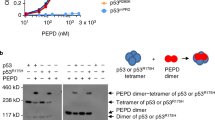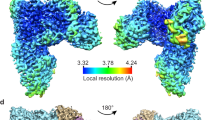Abstract
The molecular basis that the viral oncoproteins, including HPV16 E6 and E1B55k/E4 34k complex, differentially target p53 but not its homolog p73 for degradation remains elusive. Using a series of p53/p73 chimeras, we demonstrated that despite binding to the different regions of p53, both HPV16 E6 and E1B55k/E4 34k required a very same p53 sequence, amino acid residues 92 to 112 [p53(aa.92–112)], previously identified as a necessity for Mdm2-mediated degradation, to target p53 for degradation. Removal of the p53(aa.92–112) by either substitution or deletion resulted in a p53 protein that was no longer degradable by the viral proteins. More significantly, swapping the oncoprotein-binding motif and the p53(aa.92–112) rendered p73 susceptible to oncoprotein-mediated degradation. Collectively, our data supports a model in which the p53(aa.92–112) functions as a determinant for p53 stability while the binding of the oncoproteins directs p53 into the specific pathway for proteolysis.
This is a preview of subscription content, access via your institution
Access options
Subscribe to this journal
Receive 50 print issues and online access
$259.00 per year
only $5.18 per issue
Buy this article
- Purchase on Springer Link
- Instant access to full article PDF
Prices may be subject to local taxes which are calculated during checkout





Similar content being viewed by others
References
Armstrong JF, Kaufman MH, Harrison DJ, Clarke AR . 1995 Curr. Biol. 5: 931–936
Balint E, Bates S, Vousden KH . 1999 Oncogene 18: 3923–3929
Crook T, Ludwig RL, Marston NJ, Willkomm D, Vousden KH . 1996 Virology 217: 285–292
Dobbelstein M, Wienzek S, Konig C, Roth J . 1999 Oncogene 18: 2101–2106
Dobbelstein M, Roth J . 1998 J. Gen. Virol. 79: 3079–3083
Donehower LA, Harvey M, Slagle BL, McArthur MJ, Montgomery Jr CA, Butel JS, Bradley A . 1992 Nature 356: 215–221
Donehower LA . 1996 Semin. Cancer Biol. 7: 269–278
Gu JJ, Chen DL, Rosenblum J, Rubin R, Yuan ZM . 2000 Mol. Cell. Biol. 20: 1243–1253
Haupt YR, Maya M, Kazaz A, Oren M . 1997 Nature 387: 296–299
Huibregtse J, Scheffner M, Howley P . 1991 EMBO J. 10: 4129–4135
Jost C, Martin M, Kaelin WG . 1997 Nature 389: 191–194
Kaghad M, Bonnet H, Yang A, Creancier L, Biscan JC, Valent A, Minty A, Chalon P, Llias J-M, Damont X, Ferrara P, McKeon F, Caput D . 1997 Cell 90: 809–819
Kao CC, Yew PR, Berk AJ . 1990 Virology 179: 806–814
Kubbutat MHG, Jones SN, Vousden KH . 1997 Nature 387: 299–303
Levine AJ . 1997 Cell 88: 323–329
Li X, Coffino P . 1996a J. Biol. Chem. 27: 4447–4451
Li X, Coffino P . 1996b J. Virol. 70: 4509–4516
Marin MC, Jost CA, Irwin MS, DeCaprio JA, Caput D, Kaelin WG . 1998 Mol. Cell Biol. 18: 6316–6324
Marston NJ, Jenkins JR, Vousden KH . 1995 Oncogene 10: 1709–1725
Prabhu NS, Somasundaram K, Satyamoorthy K, Herlyn M, El-Deiry WS . 1998 Int. J. Oncol. 13: 5–9
Querido E, Marcellus RC, Lai A, Charbonneau R, Teodoro JG, Ketner G, Branton PE . 1997 J. Virol. 71: 3788–3798
Roth J, Konig C, Wienzek S, Weigel S, Ristea S, Dobbelstein M . 1998 J. Virol. 72: 8510–8516
Scheffner M, Werness BA, Huibregtse JM, Levine AJ, Howley PM . 1990 Cell 63: 1129–1136
Scheffner M, Huibregtse J, Vierstra R, Howley PM . 1993 Cell 75: 495–505
Steegenga WT, Shvarts A, Riteco N, Bos JL, Jochemsen AG . 1999 Mol. Cell Biol. 19: 3885–3894
Yew PR, Berk AJ . 1992 Nature 357: 82–85
Zeng X, Chen L, Jost CA, Maya R, Keller D, Wang X, Kaelin Jr WG, Oren M, Chen J, Lu H . 1999 Mol. Cell Biol. 19: 3257–3266
Acknowledgements
This work was supported by the startup fund from the Harvard School of Public Health. We would like to thank Drs P Howley, Y Shi, P Leder, JB Little, C Maki (Harvard University) and T Shenk (Princeton University) for providing reagents.
Author information
Authors and Affiliations
Rights and permissions
About this article
Cite this article
Gu, J., Rubin, R. & Yuan, ZM. A sequence element of p53 that determines its susceptibility to viral oncoprotein-targeted degradation. Oncogene 20, 3519–3527 (2001). https://doi.org/10.1038/sj.onc.1204454
Received:
Revised:
Accepted:
Published:
Issue Date:
DOI: https://doi.org/10.1038/sj.onc.1204454
Keywords
This article is cited by
-
Structure of the E6/E6AP/p53 complex required for HPV-mediated degradation of p53
Nature (2016)
-
p53 in human embryonal carcinoma: identification of a transferable, transcriptional repression domain in the N-terminal region of p53
Oncogene (2005)
-
PCAF is a coactivator for p73-mediated transactivation
Oncogene (2003)



